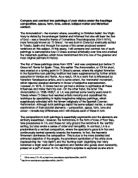Coronation of the Virgin Mary by Guariento di Arpo
De Mesa
Bettina De Mesa (Page 1)
Holmes
Art History 100
16 November 2012
Coronation of the Virgin Altarpiece
Preceding the illustrious masters of the Renaissance, Guariento di Arpo demonstrated his adroitness as a painter by forming a grandiose version of the Coronation of the Virgin. Chronicling the experimental era of art in the 1300s, the altarpiece’s 86 by 104-3/8 inch stature certainly awed the religious figures who commissioned this ornament for their church. Created in an era where most citizens were illiterate, the altarpiece probably served as a visual narrative for the church attendees who were deprived of the knowledge needed to read. Painted on numerous panels, this polyptych utilizes the use of Tempera paint and gold leaf to resemble the Byzantine influence on Guariento. However, since the Gothic influence lethargically invaded Italy there was an infusion on both art styles that exudes the experimental nature of di Arpos mind.
Relying on my amateur perspective of the painting, the central panel seems to be focused around Jesus and what I presume to be the Virgin Mary. Holistically, this altar painting is a devotional piece of work that is meant to praise the story of Jesus while simultaneously inciting a feeling of repentance for those who view this art work. Since it was created with the sole intent to be placed within an altar, it was di Arpo’s duty to form a work of art that’s visually captivating as well as informative. There are a total of twenty-four individual pieces that represent the story of Christ. The most critical seems to be the largest panel in which it shows an image of Christ bestowing a crown upon the Virgin Mary’s head. I can assume that it’s symbolically stating the fact that the Virgin Mary is now the link between the mortal beings and God. The two figures are floating in mid-air while they are being heralded by angels who are placed near their heads. It is evident that these figures are celestial beings due to the incorporation of halos within each character. Moving further down the panel, there are a plethora of angels who gaze up in amazement over the event. The color that di Arpo uses in the panel is warm and inviting assumingly pandering to the audience who want to marvel at such a grand piece of art. Scattered within the panels, there are circular spaces that include the images of arbitrary saints. Each one of these saints is painted in the direction of the center altar piece further proving my hypothesis that the central theme is incorporated in the middle panel. The line of narratives that are shown on the left panel starts with the image of Jesus cradled by a cloth in a manager which is alluding to the nativity story. Consequently, the panel next to that shows an image of the three wise men who give Jesus their gifts from God. The picture on the middle left then portrays the kiss of Judas that Jesus receives which ultimately led to his demise. Logically, the next scene that came afterwards is the whipping of the Lord by the government appointed soldiers. Moreover, the bottom image on the left panel show Mary Magdalene who wept up the blood of Jesus after he was whipped by the soldiers. The red cloth on her back symbolizes the towel that she used to clean up the holy blood of Jesus. Lastly, the resurrection of Christ is then portrayed on the left, bottom right image as he is praised by both the damned and his followers. On the right panel it portrays the numerous anecdotes about Jesus and his crucifixion. I think that the pivotal aspect of the right panel is the bottom right image which shows Jesus being lifted up into heaven by these cherub-esque angels. The portrait of Jesus is floating in mid-air validating the assumption that he is the son of God.








